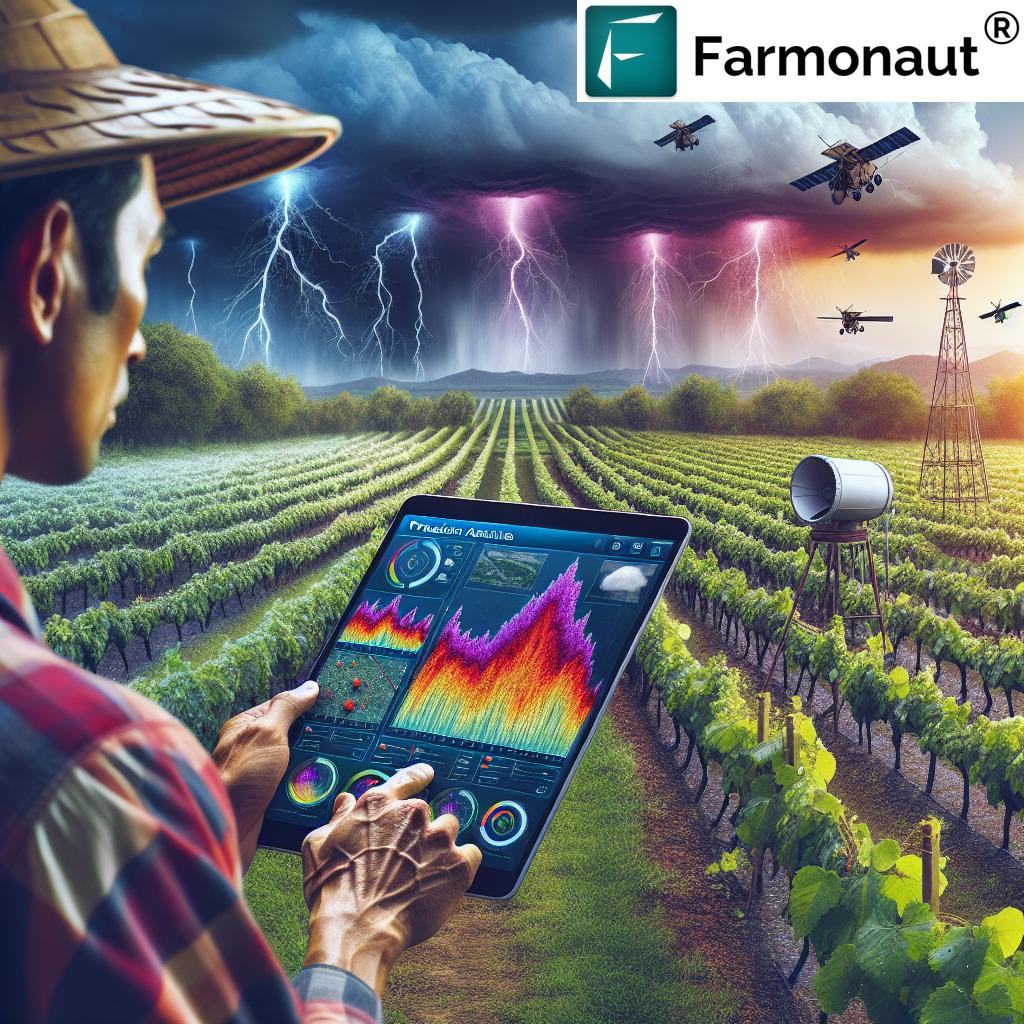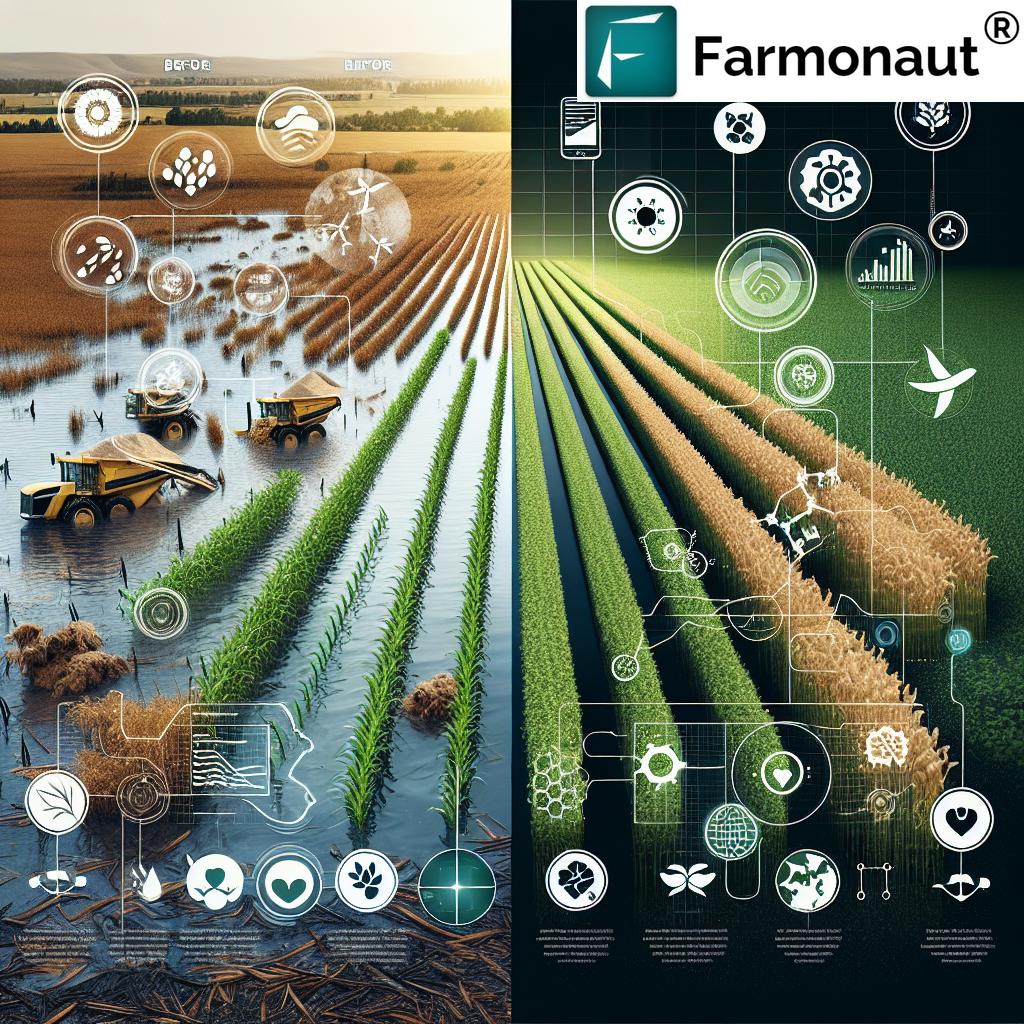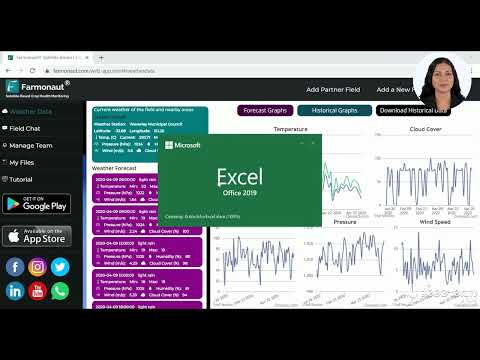Farmonaut’s Guide: Precision AgTech Solutions for Storm Recovery and Crop Management
“Farmonaut’s precision agriculture techniques can reduce post-storm crop losses by up to 30% through targeted recovery strategies.”
When natural disasters strike, the agricultural sector often bears the brunt of the impact. Storms, floods, and other extreme weather events can devastate crops, damage property, and disrupt entire farming communities. In this comprehensive guide, we’ll explore how farmers can leverage precision agriculture technology to recover from storm damage and implement effective crop management strategies. We’ll also delve into Farmonaut’s innovative AgTech solutions that are revolutionizing the way farmers respond to and recover from natural disasters.
Understanding the Impact of Storms on Agriculture
Storms can have far-reaching consequences for farmers and rural communities. From immediate physical damage to long-term effects on soil health and crop yield, the challenges are multifaceted. Here’s a breakdown of the primary areas of concern:
- Crop damage: High winds, hail, and excessive rainfall can destroy or severely damage standing crops.
- Soil erosion: Heavy rains can wash away topsoil, leading to loss of nutrients and reduced soil fertility.
- Flooding: Waterlogged fields can lead to root rot and increased susceptibility to plant diseases.
- Infrastructure damage: Farm buildings, irrigation systems, and machinery may be damaged or destroyed.
- Livestock impact: Animals may be injured, displaced, or face health risks due to contaminated water and feed.
Given these challenges, it’s crucial for farmers to have a robust storm recovery plan in place. This is where precision agriculture and AgTech solutions come into play, offering data-driven insights and tools to expedite recovery and minimize losses.
Immediate Response: The First 48 Hours
The actions taken in the immediate aftermath of a storm are critical for minimizing damage and setting the stage for effective recovery. Here’s what farmers should prioritize in the first 48 hours:
- Safety first: Ensure the safety of family members, farm workers, and livestock before assessing property damage.
- Document the damage: Take photos and videos of affected areas for insurance claims and disaster relief applications.
- Secure livestock: Move animals to safe, dry areas and check for injuries or health issues.
- Prevent further damage: Cover damaged structures, remove debris, and take steps to prevent water ingress where possible.
- Contact relevant authorities: Report damage to local agricultural offices and insurance providers.
Farmonaut’s satellite-based crop health monitoring system can play a crucial role in this initial assessment phase. By providing real-time imagery of your fields, it allows for a rapid overview of the extent of crop damage, even in areas that may be difficult to access physically.

Damage Assessment: Leveraging AgTech for Precision
Once immediate safety concerns are addressed, a thorough damage assessment is crucial. This is where Farmonaut’s advanced AgTech solutions truly shine, offering farmers unprecedented insights into their fields’ condition.
Satellite-Based Crop Health Monitoring
Farmonaut’s satellite imagery provides a comprehensive view of crop health across entire fields. By analyzing multispectral data, we can determine:
- Vegetation health index (NDVI) to identify areas of crop stress or loss
- Soil moisture levels to detect waterlogging or drought conditions
- Crop area estimation to quantify the extent of damage
This data allows farmers to make informed decisions about where to focus their recovery efforts and which areas may require replanting or alternative management strategies.
AI-Powered Advisory Systems
Our Jeevn AI advisory system analyzes satellite data alongside weather forecasts and historical crop performance to provide personalized recommendations for storm recovery. This might include:
- Suggestions for emergency crop treatments to mitigate flood or wind damage
- Recommendations for soil amendments to address erosion or nutrient leaching
- Tailored pest and disease management strategies for storm-affected crops
By integrating these AI-driven insights with on-the-ground observations, farmers can develop a targeted and effective recovery plan.
Crop Management Strategies for Storm Recovery
With a clear understanding of the damage, it’s time to implement recovery strategies. Here are some key approaches, enhanced by Farmonaut’s precision agriculture tools:
1. Soil Health Restoration
Storms can severely impact soil health through erosion, compaction, and nutrient leaching. Our satellite-based soil moisture monitoring can help farmers:
- Identify areas requiring immediate drainage or erosion control measures
- Determine optimal timing for soil amendment applications
- Monitor the effectiveness of soil restoration efforts over time
Pro Tip: Consider cover crops to help prevent further erosion and improve soil structure in severely affected areas.
2. Targeted Replanting and Crop Selection
For areas where crops have been completely destroyed, replanting may be necessary. Farmonaut’s crop area estimation tools can help farmers:
- Accurately measure the extent of areas requiring replanting
- Identify suitable alternative crops based on the remaining growing season and soil conditions
- Optimize resource allocation for replanting efforts
Remember: Choose fast-maturing varieties or consider cover crops if it’s too late in the season for your primary crop.
3. Enhanced Pest and Disease Management
Storm-damaged crops are often more susceptible to pests and diseases. Our AI-powered advisory system can provide:
- Early warnings for potential pest or disease outbreaks based on weather conditions and crop stress levels
- Recommendations for preventive treatments or biological control methods
- Guidance on optimal timing and application of pest control measures
Important: Always prioritize integrated pest management (IPM) approaches to minimize environmental impact and promote long-term resilience.

Specialized Strategies for Vineyard and Orchard Recovery
“Hail-affected vineyards can recover up to 80% of their yield potential with proper management and timely intervention.”
Vineyards and orchards face unique challenges in storm recovery due to the perennial nature of their crops. Here’s how Farmonaut’s precision agriculture tools can assist:
1. Hail Damage Assessment and Recovery
Hail can cause significant damage to grapevines and fruit trees. Our satellite imagery and AI analysis can help growers:
- Quantify the extent of canopy damage across the vineyard or orchard
- Identify areas requiring immediate pruning or training to promote recovery
- Monitor the effectiveness of recovery treatments over time
Tip: Consider applying protective fungicides to prevent disease entry through hail-damaged tissues.
2. Flood Impact Mitigation
Excessive rainfall and flooding can lead to root asphyxiation and increased disease pressure. Farmonaut’s soil moisture monitoring can assist in:
- Identifying areas with poor drainage that may require intervention
- Guiding decisions on temporary flood mitigation measures
- Monitoring root zone moisture levels to prevent over-irrigation during recovery
Remember: Proper aeration of the root zone is crucial for recovery from waterlogging.
Long-Term Planning and Risk Mitigation
While immediate recovery is crucial, long-term planning is essential for building resilience against future storm events. Farmonaut’s AgTech solutions can play a vital role in this process:
1. Climate-Smart Crop Selection
Our historical weather data and AI-driven crop performance analysis can help farmers:
- Identify crop varieties best suited to local climate trends and extreme weather patterns
- Optimize planting schedules to minimize exposure to peak storm seasons
- Develop diversified cropping systems to spread risk
2. Infrastructure Improvements
Analyzing storm impact patterns through our satellite imagery can guide decisions on:
- Strategic placement of windbreaks or storm shelters
- Improvements to drainage systems and erosion control measures
- Upgrades to farm buildings and equipment storage facilities
3. Precision Resource Management
Farmonaut’s tools for fleet and resource management can help farms:
- Optimize the use of machinery and labor during critical recovery periods
- Improve overall farm efficiency to build financial resilience
- Track and reduce carbon footprint, contributing to long-term sustainability
Access Farmonaut’s precision agriculture tools:
Sustainable Farming Practices for Disaster-Prone Areas
Implementing sustainable farming practices is crucial for long-term resilience, especially in areas prone to natural disasters. Here’s how Farmonaut’s AgTech solutions can support sustainable agriculture:
1. Conservation Tillage
Minimizing soil disturbance can improve soil structure and water retention capacity, making fields more resilient to both floods and droughts. Our soil moisture monitoring can help farmers:
- Track the impact of conservation tillage on soil moisture levels
- Optimize timing of field operations to minimize soil compaction
- Monitor improvements in soil health over time
2. Agroforestry and Intercropping
Integrating trees and diverse crops can provide natural windbreaks and improve soil stability. Farmonaut’s satellite imagery and AI analysis can assist in:
- Designing optimal agroforestry layouts for maximum protection
- Monitoring the growth and health of tree crops alongside annual crops
- Assessing the impact of intercropping on overall farm resilience
3. Water Management Systems
Efficient water management is crucial for both flood mitigation and drought resilience. Our precision agriculture tools can help farmers:
- Design and monitor the effectiveness of contour bunds and terraces
- Optimize irrigation systems for water conservation
- Track soil moisture levels to prevent over-irrigation or water stress
Leveraging Technology for Disaster Preparedness
Being prepared for future storms is just as important as recovering from past events. Farmonaut’s advanced AgTech solutions offer powerful tools for disaster preparedness:
1. Early Warning Systems
Our integration of satellite data with weather forecasting models provides farmers with:
- Timely alerts for approaching storms or extreme weather events
- Customized recommendations for pre-storm preparations
- Real-time updates on changing weather conditions
2. Risk Mapping
By analyzing historical storm data and farm-specific information, we can help create detailed risk maps that show:
- Areas of the farm most vulnerable to flooding or wind damage
- Optimal locations for storm shelters or equipment storage
- Potential evacuation routes for livestock
3. Scenario Planning
Our AI-powered advisory system can assist farmers in developing and testing various disaster response scenarios, including:
- Crop protection strategies for different types of storm events
- Resource allocation plans for rapid post-storm recovery
- Long-term adaptation strategies for changing climate patterns
Explore Farmonaut’s API for custom integrations: Farmonaut API
Access our comprehensive API documentation: API Developer Docs
Financial Recovery and Support Programs
Recovering from storm damage often requires significant financial resources. Here’s how farmers can access support and how Farmonaut’s technology can assist in the process:
1. Government Disaster Relief Programs
Many countries offer disaster relief funds for affected farmers. Farmonaut’s detailed damage assessment reports can help:
- Provide accurate documentation for relief applications
- Quantify crop losses for compensation claims
- Track recovery progress for ongoing support eligibility
2. Crop Insurance Claims
Our satellite-based verification system can streamline the crop insurance claim process by:
- Providing objective evidence of crop damage extent
- Offering historical data to compare pre- and post-storm conditions
- Facilitating faster claim processing through digital documentation
3. Alternative Funding Sources
In addition to traditional support programs, farmers can explore:
- Microfinance options for small-scale recovery projects
- Crowdfunding platforms for community-supported recovery
- Partnerships with agribusinesses for shared risk management
Community Resilience and Knowledge Sharing
Building resilience against storms is not just an individual farm effort but a community-wide endeavor. Farmonaut supports community resilience through:
1. Data Sharing Platforms
Our technology enables the creation of regional data-sharing networks where farmers can:
- Share real-time storm impact information
- Collaborate on recovery strategies
- Pool resources for more effective disaster response
2. Training and Education
We offer comprehensive training programs on using our AgTech solutions for disaster preparedness and recovery, including:
- Workshops on interpreting satellite imagery for crop health assessment
- Webinars on integrating AI advisories into farm management
- Community outreach programs on sustainable farming practices
3. Collaborative Research
Farmonaut partners with agricultural research institutions to:
- Analyze large-scale storm impact data
- Develop new crop varieties with improved storm resistance
- Create predictive models for future climate scenarios
Conclusion: Empowering Farmers in the Face of Adversity
As we’ve explored throughout this guide, recovering from storm damage and managing crops in the aftermath of natural disasters is a complex challenge. However, with the power of precision agriculture and advanced AgTech solutions like those offered by Farmonaut, farmers are better equipped than ever to face these challenges head-on.
By leveraging satellite-based crop health monitoring, AI-driven advisory systems, and data-driven decision-making tools, farmers can:
- Rapidly assess and respond to storm damage
- Implement targeted recovery strategies for optimal results
- Build long-term resilience against future extreme weather events
- Contribute to more sustainable and climate-smart agricultural practices
Remember, the key to successful storm recovery and crop management lies in being proactive, staying informed, and embracing innovative technologies. With Farmonaut’s comprehensive suite of AgTech solutions, farmers have a powerful ally in their journey towards more resilient and productive agriculture.
Are you ready to transform your approach to storm recovery and crop management? Explore Farmonaut’s precision agriculture tools today and take the first step towards a more resilient farming future.
Storm Recovery Action Plan for Farmers
| Recovery Stage | Action Items | Farmonaut AgTech Solutions | Expected Outcomes |
|---|---|---|---|
| Immediate Response |
– Ensure safety of people and livestock – Document damage – Secure property |
– Real-time satellite imagery – Mobile app for damage reporting |
– Rapid situation assessment – Prioritized response actions |
| Damage Assessment |
– Conduct aerial surveys – Assess crop and soil health – Evaluate infrastructure damage |
– Satellite Imagery Analysis – AI-powered crop health assessment – Soil moisture monitoring |
– Accurate mapping of affected areas – Quantified crop loss estimates – Targeted recovery planning |
| Crop Health Monitoring |
– Monitor for disease outbreaks – Assess nutrient deficiencies – Track recovery progress |
– NDVI analysis – AI advisory system – Time-lapse vegetation monitoring |
– Early detection of crop health issues – Optimized intervention strategies – Data-driven recovery tracking |
| Long-term Planning |
– Implement soil conservation measures – Develop climate-resilient crop plans – Invest in infrastructure improvements |
– Historical data analysis – Climate-smart crop recommendations – Risk mapping tools |
– Enhanced farm resilience – Sustainable land management practices – Reduced vulnerability to future storms |
Frequently Asked Questions (FAQ)
Q1: How quickly can Farmonaut provide post-storm satellite imagery?
A1: Depending on satellite availability and weather conditions, we can typically provide updated imagery within 1-3 days after a storm event.
Q2: Can Farmonaut’s technology help with insurance claims?
A2: Yes, our detailed crop health assessments and damage reports can provide valuable documentation for insurance claims, potentially speeding up the process.
Q3: Is Farmonaut’s platform suitable for small-scale farmers?
A3: Absolutely! We offer scalable solutions that cater to farms of all sizes, with affordable options for small-scale operations.
Q4: How does Farmonaut’s AI advisory system account for local conditions?
A4: Our AI system integrates local weather data, soil types, and historical farm performance to provide tailored advice relevant to your specific location.
Q5: Can Farmonaut help with long-term climate adaptation strategies?
A5: Yes, our historical data analysis and climate trend predictions can assist in developing long-term adaptation plans for changing weather patterns.






